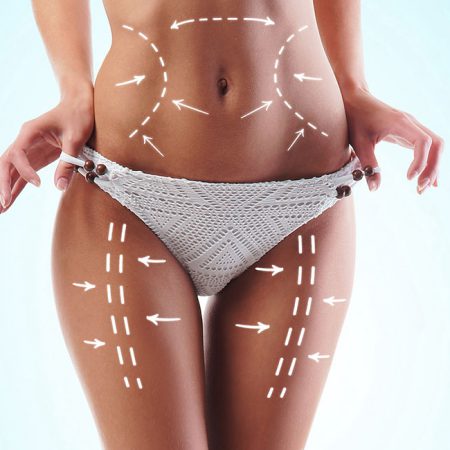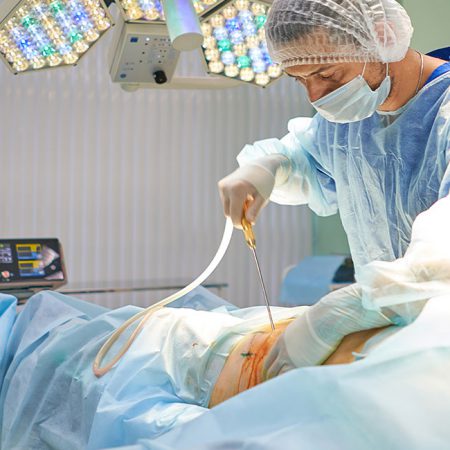Abdominoplasty surgery or Tummy Tuck as it is commonly called removes excess loose skin and fat from the abdominal area and generally also flattens & tightens the musculature and fascia of the abdomen. The surgery is meant for those who have had extreme weight fluctuations resulting in sagging skin around the abdomen. Patients who have lost significant amounts of weight, had gastric bypass surgery, gone through pregnancy or are genetically predetermined to be overweight or have stomach protrusion are candidates for abdominoplasty surgery.
What type of anesthesia is used for a tummy tuck?
Abdominoplasty surgery (tummy tuck) is performed under anesthesia and typically takes 2-3 hours to complete (full abdominoplasty).
How much skin is removed with a tummy tuck?
The amount of skin removed during an abdominoplasty largely depends on the size of the patient and the laxity of the abdominal tissue. If you remove too much, the abdomen will be too tight. The correct answer is just the right amount so that the patients belly is firm, but not so tight so as to be unnatural, restrict movement or cause discomfort.
What is the cut or incision like for a Tummy Tuck?
A full abdominoplasty entails making an incision from one side of the abdomen (hip) to the other just about the pubic area. Another incision is made vertically to the belly button in order to release the umbilical. Finally, there is an incision made around the belly button as well.
Do you tighten or repair the abdominal muscles as well?
After the first incisions are made, the abdominal tissue is then released from the abdominal wall and the excess fatty tissue and skin is removed. A centerline suture is then employed to tighten the muscle and fascia. A fibrant sealant is sometimes used before the upper abdominal tissue is pulled down and reattached with sutures to the bottom portion. Not all patients will require a muscle repair, where a mini abdominoplasty is more suited to their needs.
Abdominoplasty Expert
Our Plastic Surgeon Dr. Michael Pasquale has performed 1000s of Tummy Tuck-Abdominplasty surgeries over 25 years in Hawaii. Consultation for the procedure is without charge. So if you have questions about abdominoplasty or wonder if its the right solution for you , call us or contact us through our web form.
Who is a good candidate for a tummy tuck?
Many women and men are unhappy with the appearance and shape of their stomach or abdominal region. Regardless of dieting and exercise, these individuals find themselves unable to flatten their abdomen or reduce unwanted fat. Some of the causes of excess fat or loose skin are: past pregnancies, time and gravity, genetics or weight loss. A Tummy Tuck (Abdominoplasty) performed at our practice in Hawaii can remove droopy or flaccid skin while tightening the muscles and abdominal wall giving you a much flatter, smoother contour to your stomach. If there are minor areas of your body that you just cannot seem to flatten or tone, then Liposuction (Lipoplasty) may be what you need. A personal consultation with Dr. Pasquale will help you to realize your options, which depends on your body type and health.
What surgery is best for a flabby or fat stomach?
There are three basic techniques used to flatten a protuberant abdomen. The best technique for you will depend largely on your goals and your specific problem. Liposuction alone can produce a thin abdominal wall for some. If your laxity and excess skin is below your navel, a mini tummy tuck maybe right for you. For those with severe laxity of their abdominal muscle or excessive skin, a full tummy tuck may be their only solution.
A protuberant abdomen can be a cause of distress for men and women alike. It can be the result of excess fat, weak abdominal muscles, pregnancy, or loose skin that has been over stretched and no longer responds to diet and exercise. For those who experienced a massive weight loss, their only alternative to loose, overhanging skin is tummy tuck surgery.
What is a Mini Abdominoplasty?
A mini abdominoplasty can be best for smaller patients with less excess fat or sagging skin. The mini tummy tuck removes less tissue and releases less tissue from the abdominal wall. The use of a centerline suture is often unnecessary with a mini tummy tuck but could be used depending on the patient. As always you should consult a plastic surgeon to determine which procedures are best for you given your particular circumstances.
Tummy tuck statistics
Tummy Tuck surgery was the fifth most common surgery among women in the U.S. in the year 2020 (American Society for Aesthetic Plastic Surgery), behind Breast Augmentation, Liposuction and Eyelid Surgery (Blepharoplasty) and Nose.
Tummy tuck recovery
While a person who has undergone a tummy tuck in a healthy state may take as little as two weeks to recover, less fit patients may take significantly longer. The first few hours post tummy tuck surgery will be spent in the recovery room to adjust to the new antibiotics and painkillers. The antibiotics must be taken regularly and on time, to avoid infection. The patient must watch for fever that develops afterward, as this may be a sign of an infection.
For at least 24 hours after tummy tuck surgery, the patient will be instructed to sit in a semi reclined position. This is advised because the lying down position is usually too difficult for the patient to move up from.
The patient commonly experiences disorientation, grogginess, and memory loss from the drugs administered in the first couple of days following the procedure. Post operative depression is also a normal reaction. The drugs administered before and after tummy tuck surgery could be one of the causes of these feelings of anxiety and depression.
Swelling and bruising
The patient may feel as if the surgery has not merited any result, as he or she may leave feeling swollen and bruised from the tummy tuck surgery. Swelling and bruising are completely normal and should not be taken as a sign that the tummy tuck surgery was unsuccessful.
Swelling or bruising in the pubic mound may appear even though no surgery had been performed in this area. This swelling is medically referred to as edema, which is an excess accumulation of fluid. With much swelling post-operatively in the abdominal area, the swelling will generally tend to gravitate downward. Bruising will also move in this direction. With time, this will also subside.
Bathing instructions
The instructions given to each patient may vary, but patients are normally advised not to bathe or shower for at least two days following the surgery. Some patients may be advised not to shower for as much as a week after. Light sponge baths may be administered. When showers are allowed, the patient is advised to keep the pressure of the running water light and to only wet their back areas.
Exercise
Aerobic activities must be avoided up to at least three weeks post surgery, but walking around is advised as this will help prevent blood clotting and will ease the swelling.
Scarring
Some scarring should be expected. Scars will tend to get worse before they get better, but will fade in time.
Tummy tuck complications and possible risks
Although there are risks involved with any kind of surgery the risks involved with abdominoplasty surgery are rare. Its important that you follow the instructions given to you by your plastic surgeon so that these risks can be avoided.
- Some of the risks of abdominoplasty surgery are:
- Seroma
- Hemotoma
- Infection
- Blood Clot
- Excess Bleeding
- Nerve Damage
- Complications from anesthesia
- Persistent swelling
- Necrosis
- Excess swelling
With a qualified surgeon, the results of tummy tuck surgery can make an enormous difference. However there are always risks and uncertainties associated with all surgeries, depending on the patient’s general well-being and state of mind. One of the first dangers to be considered is the risk of an allergic reaction to the anesthetic or other drugs administered during surgery. Rare but possible is the risk that the patient may continue bleeding post operatively. In this case, another operation will be necessary to drain the collected blood from the body.
A blood clot may form due to immobilization after surgery. Moving around and keeping active as early as possible after surgery can help alleviate this risk by improving circulation of the blood. It is normal for the patient to expect some drainage from the skin incision. If the fat tissue dies internally from lack of blood supply, it may leak as an orange-ish and clear fluid.
Post surgery, the patient may experience a degree of numbness in the abdominal area. Much of the abdominal tissue is adjusted and re-adjusted during the tummy tuck procedure. The nerves on the walls of the abdomen may be stretched or divided, as tissue is removed and reconnected. While it is true that there is a risk that this loss of feeling may be permanent, most patients completely recover. The re-draping and re-adjustment of tissue can also result in temporary distortions in the appearance of the stomach. These distortions do tend to even out during the healing process. They may also be treated with liposuction or skin excision procedures. The appearance of the belly button may also change.
Patients may or may not experience post-operative pain. If needed, painkillers in the form of tablets or injections may be administered. There are rare cases when the patient may experience real life-threatening dangers such as heavy bleeding, infection, lung problems. These risks are increased in smokers and people who have diabetes. It is important to talk with your doctor to understand the surgery and your own personal risks involved.
Tummy Tuck patient vs Liposuction patient
In other words, a tummy tuck is for one particular problem and liposuction is for another. Abdominoplasty & Liposuction surgery treat two completely separate issues. The abdominal pictures below show the difference between a liposuction candidate and an abdominoplasty candidate. The main factors are below:
Tummy tuck candidate
- 1. Loose Skin
- 2. Separation of Abdominal Muscles
Liposuction candidate
- 1. Simply want to get rid of fat and skin is not an issue.
- 2. Abdominal Muscles are not separated.
In medicine, the proper diagnosis must be the first order of business, then one decides on the best treatment, Plastic Surgery is no different. Dr. Pasquale will have to determine what your diagnosis is. It is not simply “I am heavy around the midline”, so liposuction is the perfect answer. If the muscle is weak you will need a tummy tuck so these muscles can be tightened. If there is loose skin, that will look worse after liposuction, you made need a tummy tuck so that excess skin can be removed.
Occasionally we have seen patients who have needed a tummy tuck, but only had liposuction because the other doctor did not know how to perform a tummy tuck. The patient looked far worse after the liposuction from the pictures they showed us. The skin was loose and sagged like a deflated balloon. We want to make sure that your choice in procedure is the correct one. The surgeon you choose should be experienced in Liposuction and Tummy Tuck as is Dr. Pasquale with many years of training and experience.
At our Hawaii Clinic, Dr. Pasquale will evaluate you to determine your exact diagnosis, so he can best advise you as to the procedure that is needed or if a combination of liposuction and tummy tuck is needed. This is critical to a successful outcome. Dr. Pasquale is a fully trained board certified plastic surgeon who has the complete skills and knowlesdge to perform both procedures. He performs liposuction and tummy tuck often as a fully trained plastic Surgeon in Hawaii.



